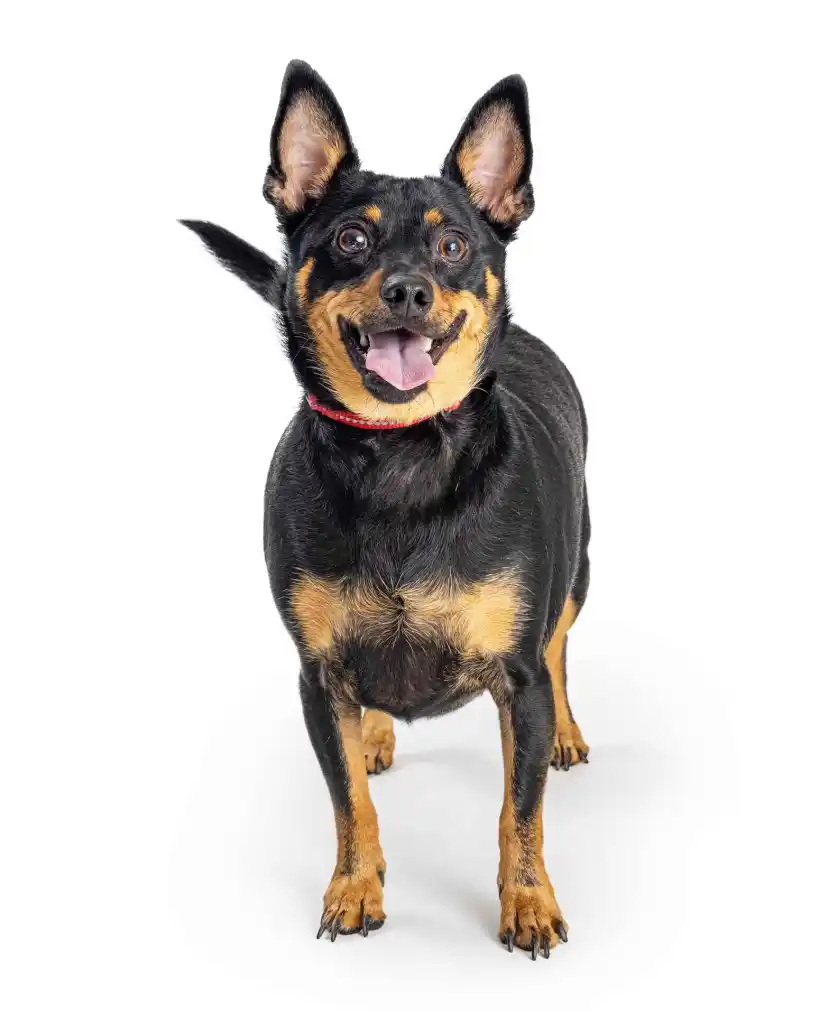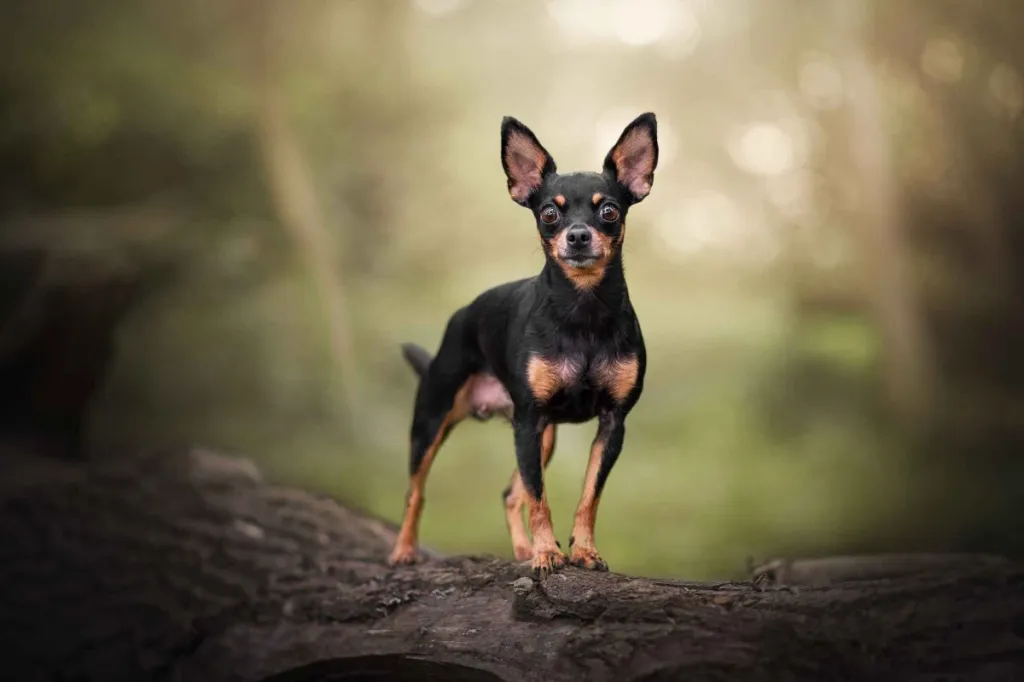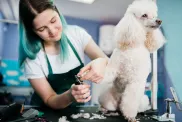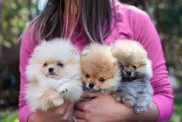The Chipin is a small-sized crossbreed between the spunky Chihuahua with the determined Miniature Pinscher. These dogs typically inherit the best traits from both parent breeds, combining the Min Pin’s spirited and confident nature with the Chihuahua’s affectionate and loyal demeanor. Chipins are small in size, usually weighing between 5 to 15 pounds, with a height of 8 to 12 inches. Their appearance can vary, but they often have short, sleek coats and come in a variety of colors, including black, brown, tan, and cream. Due to their small size and bold personalities, Chipins make excellent companions for apartment dwellers and families looking for a lively, compact dog.
Despite their small stature, Chipins are known for being fearless and alert, often taking on watchdog duties in the home. They can be somewhat territorial and might display a little wariness around strangers, but with proper socialization, they can adapt well to different environments. These dogs are highly intelligent and enjoy learning tricks or participating in agility activities. However, they can also have a stubborn streak, which may require patience during training. Chipins thrive on attention and love to be involved in family activities, making them affectionate and loyal pets that bond closely with their owners.
Chipin characteristics
- Height: 8 to 12 inches at the shoulder
- Weight: 5 to 15 pounds
- Lifespan: 10 to 14 years
Coat and color variations
The Chipin has a short, smooth coat that is typically sleek and easy to maintain, a trait inherited from both the Miniature Pinscher and Chihuahua. Their coat is often low-shedding, but regular brushing helps keep it in good condition. Chipins can come in a variety of colors, with the most common being black, brown, tan, and cream. Some may also have bi-color or tri-color combinations, with markings on the chest, face, and paws. Their coats are usually solid or combine these colors in distinct patterns, particularly black and tan or chocolate and cream.
Physical traits and appearance
Build:
- Small and compact with a muscular, well-defined body.
- The tail may be straight and carried high or slightly curled over the back, often medium in length.
- Small, neat paws that are well-proportioned to their compact body.
Head:
- A small, wedge-shaped head with a tapering muzzle.
- The head can resemble either the Chihuahua’s rounder skull or the Miniature Pinscher’s more refined structure.
- Erect and pointed ears are most common, though some Chipins may inherit the Chihuahua’s floppy ears.
- The Chipin’s nose is typically black, though it can be brown or lighter depending on coat color.

Chipin history
The Chipin is a relatively recent hybrid breed, created by crossing a Miniature Pinscher with a Chihuahua. As with most designer breeds, the Chipin doesn’t have a long-established history but was likely developed in the last few decades when the popularity of intentionally bred mixed dogs surged. The goal of crossing the Miniature Pinscher and Chihuahua was to combine the best qualities of both breeds—resulting in a small, energetic, and affectionate companion dog.
While the Miniature Pinscher, sometimes called the “King of Toys,” is often mistaken for a small Doberman, it is an older breed that dates back several centuries in Germany. Originally bred to hunt rats and other vermin, the Miniature Pinscher is known for its fearless, spirited personality and sleek, elegant appearance.
The Chihuahua, on the other hand, has a long and mysterious history. Believed to have descended from the ancient Techichi dogs of Mexico, Chihuahuas were companions to the Toltec and Aztec civilizations and later became popular in the United States in the 19th century. They are known for their loyal, alert nature and small, portable size.
By combining these two breeds, breeders aimed to create a dog with the boldness, alertness, and sleek appearance of the Miniature Pinscher, paired with the loyalty and affection of the Chihuahua. The Chipin quickly gained popularity among those seeking a small, adaptable dog that could serve as both a loyal companion and a watchful protector of the household. While they are not recognized by major kennel clubs like the AKC, Chipins are appreciated for their unique blend of traits and have become well-loved in homes across the globe.
Chipin personality
The Chipin is a lively, confident, and affectionate little dog with a bold personality. Known for their high energy and curiosity, Chipins are always on the lookout for excitement. They are intelligent and eager to learn, though they can also be a bit stubborn, inheriting an independent streak from both parent breeds. Chipins are incredibly loyal and form strong bonds with their owners, often becoming quite attached and protective. While they can be wary of strangers and display a watchdog mentality, they are generally friendly and sociable when properly socialized. Despite their small size, they have a fearless attitude, making them both charming and spunky companions for families and individuals alike.
Temperament and behavior
- Lively: Full of energy and enthusiasm, always ready for play or an adventure.
- Confident: Fearless and bold, with a self-assured attitude.
- Affectionate: Forms strong bonds with their family and enjoys being close to their humans.
- Intelligent: Quick learners, though they may show some stubbornness during training.
- Loyal: Very attached to their family, often acting as little protectors.
- Alert: Always aware of their surroundings, making them good watchdogs.
- Playful: Loves to engage in games and activities, especially with toys or in agility exercises.
- Sociable (with Socialization): Can be friendly with strangers and other pets if socialized from an early age.
Training and socialization
Early socialization and positive reinforcement training are crucial due to their sensitivity and potential stubbornness. Of course, their intelligence allows them to pick up commands quickly, so early training is key to establishing good behavior from the start. Use praise, treats, and affection to reward desired behavior. Chipins respond well to positive reinforcement, and this approach will keep them motivated and engaged.
Training tips
- Be Consistent: Consistency is crucial in training. Use the same commands and routines to avoid confusion. This helps your Chipin understand what is expected of them.
- Keep Training Sessions Short and Fun: Chipins are intelligent but can lose interest if training sessions are too long or repetitive. Keep sessions short (10-15 minutes) and engage with varied activities.
- Mental Stimulation: Incorporate puzzle toys, obedience training, and interactive games into their routine to challenge their mind. A bored Chipin can become restless or destructive. Once basic obedience is established, teach more advanced commands or tricks. Their intelligence makes them excellent candidates for agility training, fetch, or scent games.
Chipin care
Caring for a Chipin involves meeting their physical, mental, and health needs to ensure they live a happy and healthy life. As a small and energetic breed, they require regular exercise, mental stimulation, and proper grooming to thrive. While they are generally low-maintenance, their high energy levels and occasional stubbornness may need special attention during training. Their small size makes them well-suited for apartment living, but they still need daily activity and interaction to keep them from becoming bored or anxious.
Chipin grooming needs
- Brushing: Their short, sleek coat requires minimal grooming. Brush them once or twice a week to remove loose fur and keep their coat shiny.
- Bathing: Bathe them every 6-8 weeks or as needed. Be sure to use a mild dog shampoo to prevent skin irritation.
- Ear Cleaning: Clean their ears regularly to prevent infections, especially if they have the floppy ears of the Chihuahua parent.
- Nail Trimming: Trim their nails every 3-4 weeks or as needed to prevent overgrowth and discomfort.
- Teeth Brushing: Brush their teeth 2-3 times a week to prevent dental issues, using dog-safe toothpaste.
Chipin exercise requirements
- Daily Exercise: Chipins are active and energetic, needing at least 30 to 60 minutes of exercise per day. This can include brisk walks, playtime, or interactive games like fetch.
- Mental Stimulation: Engage them with puzzle toys, training sessions, or activities that challenge their minds, as they are intelligent dogs that need mental enrichment.
- Indoor Play: Chipins can burn off energy indoors, so interactive toys and games can help, especially in smaller living spaces like apartments.
Flea, tick, and parasite control
Keep up with flea and tick prevention treatments, especially if your Chipin spends much time outdoors. Regular grooming allows you to spot parasites early.
Early acclimation is key
Getting your Chipin accustomed to grooming procedures from a young age makes the process easier and more enjoyable for both of you. Handle their paws frequently, examine their mouth and ears, and reward them for good behavior during grooming sessions. This positive foundation sets the stage for stress-free veterinary exams and handling throughout their lives.

Feeding and nutrition
Feeding and nutrition for a Chipin require attention to their small size and high energy levels. Like all dogs, Chipins need a well-balanced diet that provides essential nutrients to maintain their health, energy, and overall well-being. Choosing high-quality dog food and properly managing portion sizes are key to preventing weight issues.
Portion Sizes:
- Small Meals: Due to their small size, Chipins should be fed smaller, measured portions. For an average Chipin weighing between 5 to 15 pounds, about ½ to 1 cup of food per day, divided into two meals, is generally appropriate. Adjust the amount based on your dog’s activity level and weight.
- Avoid Overfeeding: Chipins are prone to obesity, so it’s crucial to avoid free-feeding or offering too many treats. Measure their food to prevent overfeeding, and monitor their weight to ensure they remain healthy.
Protein Needs:
- Protein is essential for muscle development and energy. A diet with around 18-25% protein from high-quality sources like chicken, beef, or fish is suitable for a Chipin’s daily needs. Small-breed formulas usually have the right protein content.
Chipin and family compatability
The Chipin is generally a good family dog, though their temperament can vary slightly depending on their personality and early socialization. They are affectionate, loyal, and love to be around their human family. Chipins can be excellent companions for families with older children who understand how to handle small dogs gently. Due to their small size and sometimes bold nature, they may not be the best fit for homes with very young children, as they can be sensitive to rough play and may become defensive if they feel threatened. However, with proper supervision and teaching children to respect the dog’s boundaries, they can thrive in a family environment.
When it comes to other pets, Chipins can be somewhat territorial and may exhibit a strong, protective attitude. They can get along with other dogs, especially if they’re socialized from an early age. However, they may try to assert dominance over larger dogs, so it’s important to introduce them properly to prevent conflicts. Chipins may be more cautious or aggressive toward smaller animals like cats, but early exposure and consistent socialization can help them coexist peacefully.
Chipin health issues
The Chipin breed is predisposed to some of the same conditions that the Chihuahua and Miniature Pinscher also face. While most are generally healthy, some may be prone to a few health issues. Some of the more common health problems Chipins may suffer from include:
- Hip Dysplasia: While small, Chipins can potentially inherit a risk of hip dysplasia from their parent breeds, where the hip joint doesn’t form properly leading to arthritis and lameness. Maintaining a healthy weight can help reduce the severity.
- Obesity: With their small size and tendency to be lap dogs, Chipins can easily become overweight or obese if overfed and under-exercised, putting strain on their bones and increasing obesity-related health risks.
- Eye Injury: The protruding eyes of Chipins, inherited from the Chihuahua side, make them more prone to eye injuries or irritations if not carefully handled and protected.
- Heart Disease: Both parent breeds carry some risk for inherited heart conditions like patent ductus arteriosus, so Chipins should have their hearts regularly examined by a vet.
- Cataracts: The development of cataracts, or cloudy lenses in the eyes, is a potential issue Chipins may face as they inherit some risk from the Chihuahua and Miniature Pinscher breeds.
Chipin rescue groups
It may be hard to find a breed-specific rescue for Chipins because they are a mixed breed. However, you may want to try Chihuahua or Miniature Pinscher breed-specific rescues, as they often care for mixes, as well. Here are some rescues you can try:
If you choose to search for Chipin puppies for sale, always do your research to find a reputable breeder.













